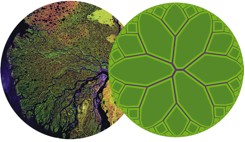Putting planning on its head
Updated on 17 July 2024
I’m no friend of “top down” planning and have often chided anyone believing that this can be done meaningfully. Reality is messy, is my jaundiced view, and there are too many factors impinging on it: seeking out a few “choice” factors for planning, and ignoring the rest, is likely to produce a maladaptive monster. Improvement is possible, in my view, but not “progress towards an imagined and final “eutopia”. In other words: “think locally”, and “for the rest hope for the best” means that one always has opportunistically to look for improving adaptations, but also be on guard against falling into the next ditch.
A recipe for “laissez faire”? No. “Messiness” need not be homogenous. Whatever the situation, there are some “bright spots” worth building on. “Bright spots”[1] are things that seem to go right in a bleak landscape of things that are wrong or seem to be going wrong. Try to make them better – it may work. Yes – it is “bootstrapping”. Yes it does not always work. While waiting for the white planning knight to deliver one from the mire – it might do some good.
Enter stage left the Constructal Law – which I have just been explained[2]: For a finite-size system to persist in time (to live), it must evolve in such a way that it provides easier access to the imposed currents that flow through it.” (pg. 3) and then goes on: “Everything that flows and moves generates designs that tends to evolve” (pg. 14), “acquiring better and better configurations to provide more access for current that flow through them” (pg. 5).
This is a physical law. As energy descends from high to low level of entropy, it does so in configurations (designs), which over time evolve toward increased efficiency. Design is an emergent property of entropy. Trees and root systems are both efficient ways to go from point –to-surface, resp. surface –to-point.

The constructal law is a “first principle” of physics that accounts for all design and evolution in nature. It holds that shape and structure arises to facilitate flow. The designs that arise spontaneously in nature reflect this tendency: they allow entities to flow more easily – to measurably move more current farther and faster for less unit of useful energy consumed[3].
Well, this new law (and it is a law, not a heuristic) would explain why we have certain “designs” in nature – like trees, or lungs – that repeat themselves in many different situations. Certain forms of hierarchical designs are inherent in nature – though they do not rely on intelligence. When planning, one should make use of these natural “designs”.
So what gives? Do we have chaos or design?
Go back to the definition, which begins with “For a finite-size system to persist in time (to live)…” and you’ll have the answer. If the system is finite-size, then, left to its own devices it will over time develop the design features. The problem is – this “self-contained” characteristic does not often apply. When finite-size systems meet the rest of the world, they interact and evolve. Creativity emerges from these encounters, and much more.
Chaos and design coexist, in a never-ending dance of necessity and contingence. Enjoy.
_________________
Originally posted at the DeepDip.
[1] See: Chip and Dan HEATH (2010): Switch: How to Change Things When Change Is Hard. Crown Business.
[2] See: Professor Adrian BEJAN – J. Peder ZANE (2012): Design in nature. How the constructal law governs evolution in biology, physics, technology, and social organization. Doubleday, New York.
Related blogs
Related events
Related resources
Subscribe to Diplo's Blog
The latest from Diplo and GIP
Tailor your subscription to your interests, from updates on the dynamic world of digital diplomacy to the latest trends in AI.
Subscribe to more Diplo and Geneva Internet Platform newsletters!
Diplo: Effective and inclusive diplomacy
Diplo is a non-profit foundation established by the governments of Malta and Switzerland. Diplo works to increase the role of small and developing states, and to improve global governance and international policy development.


Leave a Reply
Want to join the discussion?Feel free to contribute!